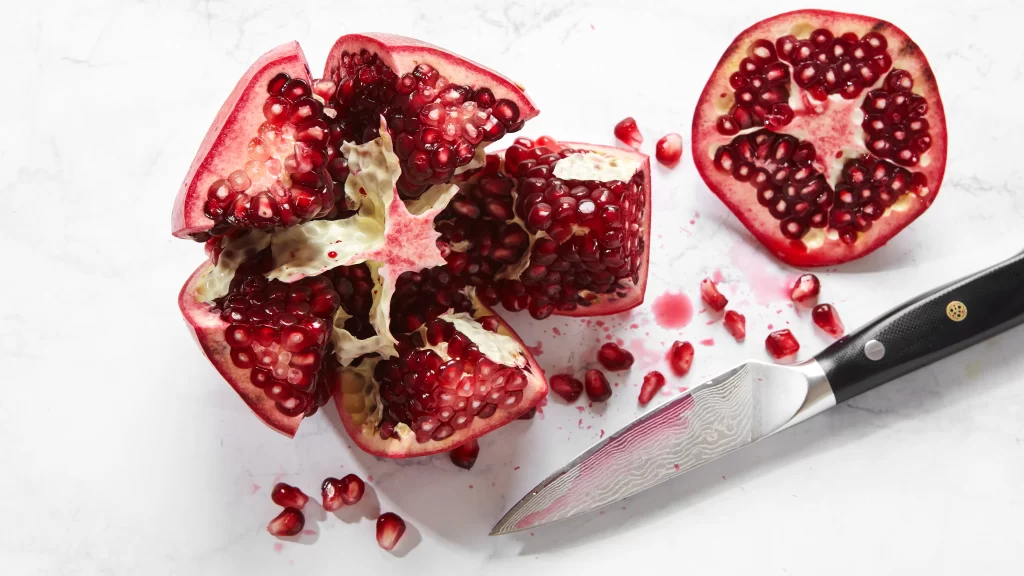How to Cut a Pomegranate: A Comprehensive Guide
Pomegranates are not only delicious but also packed with nutrients, making them a popular choice for healthy diets. However, many people find the process of cutting and extracting the seeds (arils) daunting. This guide will provide a detailed, step-by-step approach to cutting a pomegranate effectively, along with tips and tricks to make the process easier and more enjoyable.
Understanding the Pomegranate
Before diving into the cutting techniques, it’s essential to understand what a pomegranate is and why it’s beneficial.
What is a Pomegranate?
The pomegranate (Punica granatum) is a fruit-bearing deciduous shrub or small tree that belongs to the family Lythraceae. It is native to the region extending from Iran to northern India and has been cultivated since ancient times throughout the Mediterranean region and the Middle East.
Nutritional Benefits
Pomegranates are known for their high antioxidant content, particularly punicalagins and punicic acid, which contribute to various health benefits, including:
- Anti-inflammatory properties: Pomegranates can help reduce inflammation in the body.
- Heart health: The antioxidants in pomegranates may lower blood pressure and cholesterol levels.
- Cancer prevention: Some studies suggest that pomegranates may help reduce the risk of certain cancers.
- Improved memory: Pomegranate juice has been linked to improved memory function.
Choosing the Right Pomegranate
When selecting a pomegranate, look for the following characteristics:
- Color: Choose pomegranates that are deep red and vibrant in color. The skin should be smooth and free of blemishes.
- Weight: A good pomegranate should feel heavy for its size, indicating that it is full of juice.
- Shape: Opt for pomegranates that are round and plump, as this indicates that they are ripe.
Tools Needed
To cut a pomegranate effectively, you will need the following tools:
- A sharp knife
- A cutting board
- A bowl to catch the seeds
- A spoon (optional, for scooping out seeds)
Step-by-Step Guide to Cutting a Pomegranate
Step 1: Prepare the Pomegranate
- Wash the fruit: Rinse the pomegranate under cool water to remove any dirt or residues.
- Dry the fruit: Pat the pomegranate dry with a clean towel.
Step 2: Cut the Crown
- Identify the crown: The crown is the top part of the pomegranate where the flower once bloomed.
- Slice off the crown: Use a sharp knife to cut off the crown, making sure not to cut too deep into the fruit. This will expose the inner sections of the pomegranate.
Step 3: Score the Skin
- Make shallow cuts: Using the knife, make shallow cuts from the top to the bottom of the pomegranate, following the natural ridges of the fruit. Aim for about 4-6 cuts around the fruit.
- Be careful: Ensure that you do not cut too deep, as you want to avoid slicing through the seeds.
Step 4: Open the Pomegranate
- Gently pull apart: Use your hands to gently pull apart the sections of the pomegranate. The fruit should easily separate along the cuts you made.
- Place in a bowl: As you pull apart the sections, hold them over a bowl to catch any juice that may spill.
Step 5: Remove the Seeds
- Loosen the seeds: Use your fingers to gently loosen the seeds from the white pith. The seeds should fall out easily.
- Use a spoon (optional): If you prefer, you can use a spoon to scoop out the seeds from each section.
Step 6: Enjoy the Seeds
- Rinse the seeds: If desired, rinse the seeds in a bowl of water to remove any remaining pith.
- Serve: Enjoy the seeds as a snack, add them to salads, or use them as a garnish for various dishes.
Tips for Cutting a Pomegranate
- Cut over a bowl: To minimize mess, cut the pomegranate over a bowl to catch any juice that may squirt out.
- Use a wooden spoon: If you want to release the seeds more easily, you can tap the back of the pomegranate sections with a wooden spoon while holding them over a bowl.
- Wear an apron: Pomegranate juice can stain clothing, so it’s a good idea to wear an apron or old clothes while cutting.
Common Mistakes to Avoid
- Cutting too deep: Avoid cutting too deep into the fruit, as this can damage the seeds and make extraction more difficult.
- Not scoring the skin: Failing to score the skin can make it challenging to open the pomegranate and extract the seeds.
- Rushing the process: Take your time to ensure that you cut and extract the seeds carefully to avoid mess and waste.
Storing Pomegranate Seeds
If you have leftover seeds, you can store them in the refrigerator for up to a week. Place the seeds in an airtight container to keep them fresh.
Conclusion
Cutting a pomegranate may seem intimidating at first, but with the right technique and tools, it can be a straightforward process. By following this guide, you can enjoy the delicious and nutritious seeds of this remarkable fruit without the hassle.
FAQ
1. How do I know if a pomegranate is ripe?
Choose pomegranates that are deep red in color, heavy for their size, and round and plump in shape.
2. Can I eat the white pith of the pomegranate?
While the white pith is edible, it is bitter and not typically consumed. It is best to focus on the juicy seeds.
3. How long do pomegranate seeds last in the refrigerator?
Pomegranate seeds can last up to a week when stored in an airtight container in the refrigerator.
4. What are some ways to use pomegranate seeds?
Pomegranate seeds can be eaten as a snack, added to salads, used as a garnish for various dishes, or incorporated into smoothies and desserts.
5. Is there an easier way to extract pomegranate seeds?
Some people find it helpful to tap the back of the pomegranate sections with a wooden spoon while holding them over a bowl to release the seeds more easily.
| Aspect | Details |
|---|---|
| Fruit Name | Pomegranate |
| Scientific Name | Punica granatum |
| Nutritional Benefits | High in antioxidants, anti-inflammatory, heart health |
| Storage | Up to one week in an airtight container |
| Wikipedia Link | Pomegranate |



